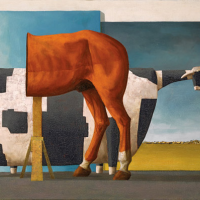37. JOHN KELLY

Despite having spent much of his life abroad in Ireland and the UK, John Kelly is best known for painting subjects that are distinctively Australian. In this sense Kelly has much in common with two of Australias most important artists of the last century, Russell Drysdale (1912-1981) and Sidney Nolan (1917-1992), who continued to render imagery of the Australian outback from their London studios. Born in Bristol in 1965, Kelly emigrated with his parents to Australia in the same year and grew up in the Melbourne working-class suburb of Sunshine. After completing a Master of Arts at Melbournes RMIT University in 1995, Kelly won a scholarship to study as an affiliate of Londons prestigious Slade School of Fine Art.1 Over the last twenty-five years, Kelly has exhibited regularly in Australia and the UK, where he has been represented by three of Londons most respected commercial venues - Piccadilly Galleries, Agnews Gallery and The Redfern Gallery. For over a decade, Kelly has lived on a farm in West Cork on the southern coast of Ireland.
Stored 1998 combines imagery from two of Kellys most celebrated series, the Dobells Cow and Phar Lap works. The latter series draws upon the uncanny history of Australias most famous racehorse. Having won the Melbourne Cup in 1930, Phar Lap became a popular symbol of Australian fortitude during the Great Depression. Following his mysterious death in the United States in 1932, Phar Laps physical remains were separated, with his mounted hide entering the collection of the Melbourne Museum. Phar Laps hide is one of the museums most popular exhibits and was expected to attract some 350,000 visitors when displayed alongside the horses skeleton (on loan from Wellingtons Dominion Museum) in 2010.2 In Kellys painting, Phar Laps neatly severed remains are propped up on a wooden crutch, revealing the divergence of popular myth from material reality. Phar Lap is presented not as the embodiment of a sporting legend, but an inanimate object that may be possessed and relocated at will.
The Dobells Cow series took its inspiration from the papier-mch models of cows created by William Dobell (1899-1970) during World War II. Employed by the Australian military as a camouflage artist, Dobells efforts were intended to protect Australian airfields from Japanese aerial attack. Dobells cows have become Kellys most enduring and distinctive motif, revealing his persistent fascination with this bizarre episode in Australian history. Although it is unclear how closely Kellys paintings resemble the original structures created by Dobell - of which little documentation remains - it is evident that Kellys camouflage cow would have had little chance of duping an observant enemy. The cows many anatomic idiosyncrasies include its square torso, stunted legs, elongated neck, tiny head and apparent absence of facial features. Nevertheless, it is not the physical integrity of Dobells cows that interests Kelly so much as what they represent both in terms of Australian culture and the nature of art itself. As the artist explains:
Theres only one literary reference in an obituary written in Readers Digest, by Dobells surgeon and theres a lot of doubt as to whether [the model cows] even existed. But to me thats not really important because the work is not about cows; its about the idea of these artists trying to camouflage things. Art is never really about what its about.3
For Kelly, Phar Laps hide and Dobells cows reflect the unique strangeness of the Australian experience, rooted in the harshness of our natural environment and relative isolation. But they also humorously embody the idea of art as artifice, refuting any notion of the artist as an impartial observer of the physical world. In Kellys paintings, nothing is really what it seems. Kellys clear interest in visual irony and dissemblance the perfidy of images brings to mind the works of Belgian surrealist Rene Magritte (1898-1967). The paintings within the painting propped against the wall in Stored are reminiscent of Magrittes two works from 1933 and 1935, both titled The Human Condition (La Condition Humaine).
John Kelly occupies an important place within Australian visual culture as one of the countrys leading proponents of post-modern figuration. As with other expatriate artists before him, Kellys geographical distance from Australia has yielded a certain insight into our national character, complemented by a wry and irreverent sense of humour.
Footnotes:
1. Kelly, J., John Kelly: Artist, http://johnkellyartist.com/more/.
2. Kirby, S., "Phar Laps skeleton reunited with hide," The Age, Melbourne, 16 September 2010, http://www.theage.com.au/victoria/phar-laps-skeleton-reunited-with-hide-20100916-15dw5.html
3. Northover, K., Cow-up-a-tree-artist John Kelly Australias most famous artist you never knew, The Age, Melbourne, 11 December 2015, http://www.theage.com.au/entertainment/art-and-design/cowupatreeartist-john-kelly--australias-most-famous-artist-you-never-knew-20151211-glld0e.html
Catherine Baxendale B Phil (Hons), MA (Art Curatorship)